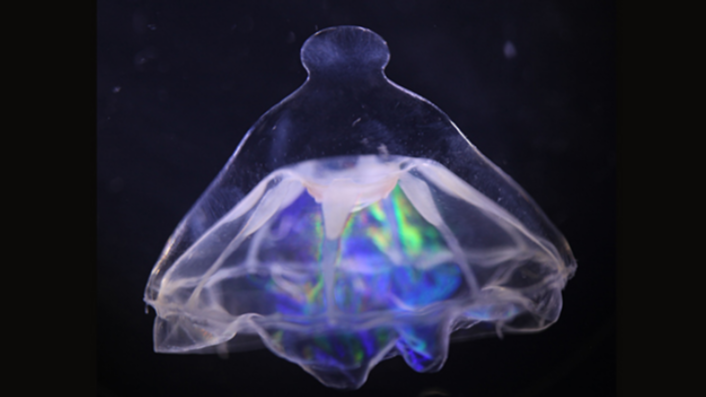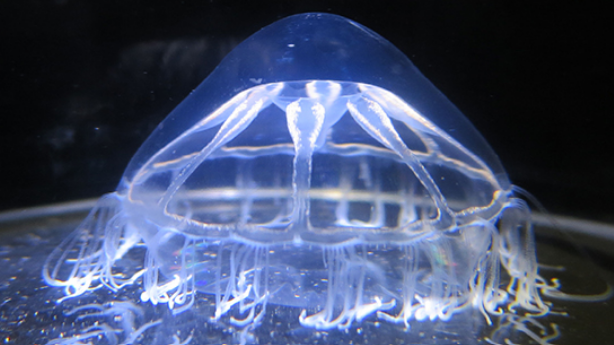A mysterious barrier in the Atlantic divides weird deep-sea jellyfish cousins
Researchers have mapped the distribution of a jellyfish subspecies and found that creatures which lack a distinctive "knob" are somehow prevented from leaving the Arctic.

A mysterious oceanic barrier is stopping some deep-sea jellyfish in the Arctic from reaching the Atlantic Ocean, a new study has found.
The animals, members of the jellyfish subspecies Botrynema brucei ellinorae, inhabit depths between 3,300 and 6,600 feet (1,000 to 2,000 meters) and can be divided into two groups based on whether individual specimens have a knob on their umbrella-like bell structure.
"This jellyfish [...] has two different shapes depending on which area it occurs in — one with a distinctive knob at the top and one without," study lead author Javier Montenegro, a biologist at the University of Western Australia, said in a statement.
The sea creature’s anatomy somehow influences its worldwide distribution: jellyfish with the distinctive knob live across all oceans and latitudes, while those without a knob have only ever been documented in the Arctic and sub-Arctic, Montenegro said.
For the study, Montenegro and his colleagues examined observational and photographic records of B. brucei ellinorae going back more than 120 years. The researchers then mapped the distribution of the jellyfish subspecies by combining these records with genetic analyses. They published their results in the online version of the journal Deep Sea Research on July 3.
Genetic data indicated that specimens of B. brucei ellinorae with and without knobs in the Arctic and sub-Arctic were almost identical to specimens with knobs in the western Atlantic. This suggested that, despite strong genetic similarities, knobless jellyfish were unable to leave the frigid waters.
Get the world’s most fascinating discoveries delivered straight to your inbox.
So how does the animal’s shape determine its distribution? It appears that access to the Atlantic is blocked by a barrier — not a physical obstacle, but a biological one, or one determined by local geography.
"The differences in shape, despite strong genetic similarities across specimens, above and below 47 degrees north, hint at the existence of an unknown deep-sea bio-geographic barrier in the Atlantic Ocean," Montenegro said.

This barrier is located within the North Atlantic Drift, a warm ocean current that extends northward from the Gulf Stream, but it's unclear if the current itself is the obstacle for knobless jellyfish. A possible explanation could be that there are predators lurking beyond the North Atlantic Drift that knobless jellies aren't equipped to escape — but why having a knob may be advantageous remains unclear.
The barrier "could keep specimens without a knob confined to the north while allowing the free transit of specimens with a knob further south," Montenegro said.
No such barrier is required to keep knobless B. brucei ellinorae in Arctic waters on the Pacific Ocean side, because the Bering Strait already blocks most deep-sea creatures from moving south, according to the study. The strait is only 165 feet (50 m) deep, so deep-sea jellyfish like B. brucei ellinorae can't cross it.
The discovery of a potential oceanic barrier associated with the North Atlantic Drift is important, as it could help scientists better understand evolutionary relationships and dispersal patterns. "The presence of two specimens with distinctive shapes within a single genetic lineage highlights the need to study more about the biodiversity of gelatinous marine animals," Montenegro said.

Sascha is a U.K.-based staff writer at Live Science. She holds a bachelor’s degree in biology from the University of Southampton in England and a master’s degree in science communication from Imperial College London. Her work has appeared in The Guardian and the health website Zoe. Besides writing, she enjoys playing tennis, bread-making and browsing second-hand shops for hidden gems.
You must confirm your public display name before commenting
Please logout and then login again, you will then be prompted to enter your display name.


